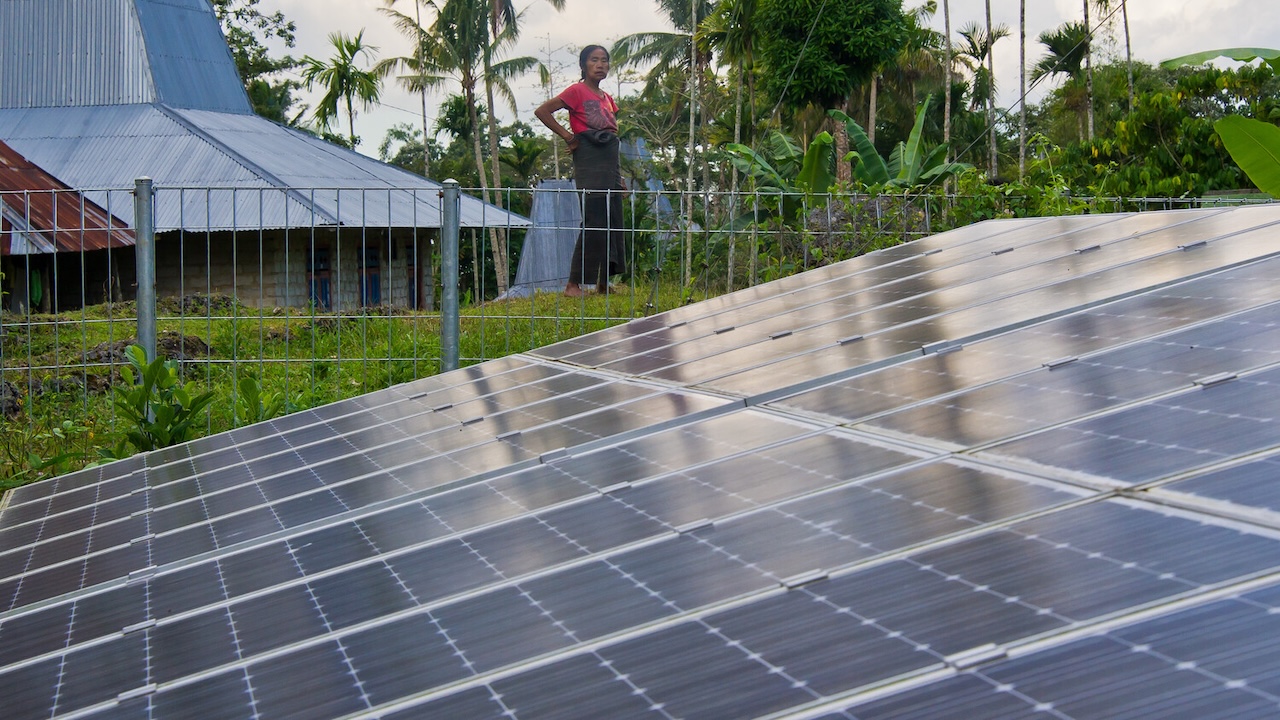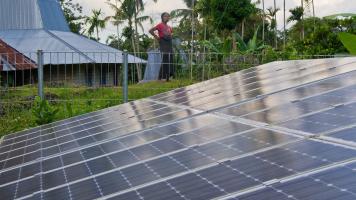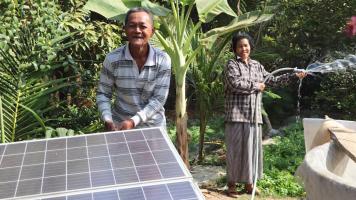
The island of Sumba in East Nusa Tenggara province has the lowest electrification ratio (92.5%) and some of the highest poverty rates in Indonesia. Photo credit: ADB.
Community's full ownership and consensus on various financing and management aspects key to successful projects even in the absence of private sector involvement.
This article is published in collaboration with the Climate Policy Initiative.
A defining element of the global effort to achieve the 1.5°C Paris Agreement goal is the commitment to a just energy transition. The shift from fossil fuels to renewable energy is instrumental in charting both decarbonization pathways and sustainable economic growth. For rural Eastern Indonesia, this requires extending reliable and affordable energy access to reach the last mile of the population. Renewable energy mini-grids can efficiently target sustainable electricity for specific locations and purposes (e.g., households and small home-based businesses) in remote areas.
While the importance of an inclusive energy transition is well reflected in Indonesia’s National Energy Policy and Enhanced NDC targets, there are various barriers to private investment in small-scale renewable energy projects. These include high unit costs, high interest rates, perceived investment risks, and a lack of de-risking instruments. As a result, there has been very little interest from the private sector to invest in such projects in Indonesia.
Drawing on a previous analysis on overcoming financing barriers to enhance decentralized renewable energy investment in Eastern Indonesia, Climate Policy Initiative (CPI) has conducted a follow-up research examining four case studies of renewable energy projects in East Nusa Tenggara and East Kalimantan.
As further inferred from these case studies, successful renewable energy implementations have one common denominator—a community-driven approach characterized by full ownership and consensus on various financing and management aspects even in the absence of private sector involvement.
Financing Rationale: Decentralized Renewable Energy to Catalyze Private Investment
CPI’s 2020 Enhancing Decentralized Renewable Energy Investment report emphasized decentralized renewable energy as a viable solution for increasing energy access and accelerating electrification in underdeveloped areas. This business model has the potential to address prevailing barriers such as limited access to finance and high investment risks that have long discouraged private investments. Through government’s active role in injecting the initial capital or asset to strengthen regionally owned enterprises and commission partnerships with the private sector, this model is expected to work under the following schemes:
- Village-Owned Enterprise and Private Sector Joint Venture
This can help address the barrier of off-taker uncertainty since village governments have an inherent understanding of local electricity users. Additionally, a capital injection from village funds can reduce reliance on costly debt financing. - Public–Private Partnership using Availability Payment Scheme
Availability payment scheme can encourage investments because this financial instrument’s regular disbursement helps to maintain the level of public service. Availability payment also ensures return on investment and helps to reduce the risk perception of local banks and other financial institutions as these instruments are supported by long-term government commitment. - Special Allocation Fund and Private Sector Joint Venture through Joint Operation Mechanism
The special allocation fund (DAK) is a grant that covers capital expenses and helps to improve projects’ return on investment. The asset will then be transferred to a village-owned enterprise and be operated by the private sector through a joint operation mechanism to ensure sustainability.
Case Studies: Community-based Renewable Energy Projects in Eastern Indonesia
While the above financing rationale describes various schemes towards the ideal outcome of increased private investment in decentralized renewable energy, our case studies of renewable energy projects in Eastern Indonesia uncover realities from the ground—there is currently very little interest from private sector to invest in these projects.
Instead, one element that we observed in several success stories is the central role of community ownership, unifying local government, village-owned enterprises, and households under a common purpose of collectively managing renewable energy grids which, in turn, yields positive impacts on the community livelihoods and local economy.
Community-based renewable energy projects distributed through mini-grids offer a unique opportunity to prioritize serving loads to certain vicinity (e.g., households and small home-based businesses), therefore ensuring more efficient and targeted distribution of sustainable and clean electricity in remote areas.
The island of Sumba in East Nusa Tenggara province formed our research focus as it has the lowest electrification ratio (92.5%) and some of the highest poverty rates in Indonesia (BPS, 2023). Our research focused on three villages on the island—Watukarere, Sumba, and Treweng—with Muara Enggelam village in East Kalimantan as a benchmark of successful rural mini-grid electrification.
In the following case studies, we closely examine various technical, economic, socio-environmental, and governance aspects that provide lessons on factors for success.
1. Muara Enggelam
The case of Muara Enggelam demonstrates how a village-owned enterprise can effectively manage and operate a solar photovoltaic (PV) grid to support livelihoods in its community. With low dependence on government funds for its operation, this case illustrates how community consensus can enhance mini-grid management.
Muara Enggelam is a remote floating village of 192 households on the Melintang Lake, which faces difficulties in accessing the national grid. The village previously used a gasoline diesel generator to electrify houses and public facilities with each household paying IDR10,000 ($0.8) per day for 6 hours of basic lighting. As the national government then gradually decreased gasoline subsidies, residents further faced increasing costs for electricity and transportation.
In 2016, the Ministry of Energy and Mineral Resources (MEMR) awarded Muara Enggelam a Special Allocation Fund of IDR3.9 billion ($250,000) to construct a 35 kilowatt-peak (kWp) communal solar grid and train local technicians to operate it. By 2020, the village-owned enterprise had developed the capacity to repair any damaged solar panels and increased the capacity to 45 kWp. This project was part of a collaboration between the provincial government and Deutsche Gesellschaft für Internationale Zusammenarbeit, which provided technical assistance on entrepreneurship and community empowerment.
Access to electricity from the solar grid enabled the pre-existing village-owned enterprise to venture into swallow’s nest farming using a sound system to mimic bird chirping. It also powered computers and other devices in public facilities including the school and health clinic. Households are also able to power televisions, cooking appliances, and lighting.
The success of Muara Enggelam demonstrates how the communal solar grid has enabled local enterprises. The revenues are also used to cross-subsidize operational and maintenance costs without additional fund needed from the village budget. The benefits the whole community now paying considerably lower electricity price at IDR50,000 ($3) compared to the previously costlier diesel at IDR80,000 ($5) per month. Both the village-owned enterprise and village government play important roles in ensuring financial sustainability. They employ clear rules on electricity payment, including subsidies for low-income households, and sanctions for electricity theft and non-paying customers. The village government also discloses the financial performance of the village-owned enterprise, including collected amounts of electricity bills at monthly community meetings.
2. Watukarere
In a less successful case, the government-funded project in Watukarere village suffers from mismanagement due to a lack of capacity, advisory support, and community ownership.
Watukarere received assets under the Physical Special Allocation Fund (DAK Fisik) from the central government in 2017 to develop a communal 30 kWp mini-grid, with 96 kWh of battery storage. While the grid was initially expected to electrify 160 households as well as the village school, office, and health center, each household receives a limited daily load of 300 watt-hour, which is usable only for lighting and phone charging, and is not enough to power productive revenue-generating activities.
At the time of our field visit, the solar grid was operating at half capacity due to limited availability and high cost of spare parts. Critical elements, including a cooling system, hydrant, and instructions, were not present, posing safety risks. The grid also lacks skilled workers, dedicated management and budget for operations and maintenance (O&M). While monthly fees had been agreed upon to cover O&M, in practice, households were receiving free electricity due to their low earnings and unwillingness to pay. Watukarere residents, primarily engaged in paddy farming and pig breeding, make around IDR300,000 ($20) per month, well below Indonesia’s average income. They rely heavily on government assistance, such as cash transfers and rice supplies. Given this lack of local revenue generation activities, the village derives its fiscal revenue solely from central government funds.
3. Mata Redi
Mata Redi’s mini-grid showcases a comprehensive end-to-end donor-led project encompassing physical infrastructure development, productive energy use, and vocational training for operators.
The project, in operation since July 2023 and funded by the United Kingdom's MENTARI program, consists of two AC-coupled solar units of 60 kWp and 35 kWp. With inverter capacities of 24 kW and 48 kW, the grid supplies 220 households, 60 lamp posts, and 13 public facilities. It powers computers, internet connectivity, and printers in schools, as well as a vaccine and insulin freezer at a village clinic. The project is managed by the village-owned enterprise with its officials (chairperson, treasurer, and secretary) appointed by the village government.
A contractor selected through competitive bidding by MENTARI led the project’s engineering procurement and construction. The equipment purchase agreement includes a 10-year manufacturer’s warranty for batteries and inverters, a 3-year service agreement for O&M, as well as assurance of operational resilience and knowledge transfer. Local capacity building is prioritized, offering training and vocational education in electrical engineering. Certification for local operators is pursued through the Indonesian National Work Competency Standards Certificate for solar PV O&M level 2, with a goal of reaching level 5.
Payment schemes are structured based on connected power, with a collection rate of 72%–82%. An inclusive payment system with instalment options is in place to accommodate delays and outstanding electricity bills, allowing residents to accumulate sufficient funds before settling their dues. While MENTARI assists in tariff determination, billing and fund management are conducted by the village-owned enterprise and village government. Initially, MENTARI subsidized the cost of IDR500,000 ($35) to connect individual household to the mini-grid. While installation costs are expected to increase once this support is terminated, residents hope that these expenses will be further subsidized by the village government and remain below PLN prices.
Mata Redi had limited productive activities prior to assistance from MENTARI. The program has been instrumental in fostering economic growth and empowering the community across technical, social, and economic dimensions. It has enabled energy use for ginger and lemongrass cultivation, wood processing, candlenuts, and other agricultural products. With support from the Regional People’s Representative Council, MENTARI has also promoted women’s empowerment by forming five women’s farmer groups in the village.
4. Treweng
The case of Treweng Island demonstrates successful use of mini-grids rooted in demand-driven approach while also highlighting the risk of stranded assets when competing sources of electricity become available.
It began in 2015 with the Ministry of Villages’ initiative to build scattered solar panels with 5 kWp capacity for each residential building. However, due to a limited budget, this program only reached 30 out of 175 houses in Treweng, causing friction between those receiving the electricity and those who did not. In a bid to equally distribute the electricity, the MEMR further granted a Special Allocation Fund worth IDR 3 billion to develop a communal solar grid with a 30 kWp capacity in 2016. As such, this could only generate enough electricity for lightning and not for productive uses of energy. Following successful implementation of this communal grid, PLN then established a new solar grid with 110 kWp capacity in 2020. This has significantly improved electricity access, enabling households to buy power based on their needs and further use it commercially such as to freeze fresh fish and repair fishing boats.
The community is now also paying less for electricity at IDR10,000 per month, compared to around IDR40,000 per month in 2015. Every month, there will be a village government official who collects electricity payments from each house and further allocated them to cover all operational expenses. This is different from the case of Muara Enggelam, where all grid operations and payment collection are managed under village-owned enterprises. Moreover, the village head plays an important role in developing technician capacity through education and training to meet the requirements of grid operation and maintenance.
On the other hand, the expansion of state electricity company PLN also caused a drawback as the previous communal solar grid ended up fully shut down and abandoned. Although the panels and inverters in the old grid were still in good condition, the village government decided to leave them stranded because there was no budget available to cover operating costs while household electricity needs could then be fully covered by the PLN grid. At the same time, PLN has stringent standards and procedures as a state-owned enterprise pertaining to asset acquisition to avoid any risk exposure and misconduct in corporate governance. This explains PLN’s reluctance to undergo transfer of assets despite their functionality.
Leveraging community-based renewable energy to accelerate rural electrification
With the exception of Watukarere, the cases show community ownership can help ensure and sustain more effective management of decentralized renewable energy projects. With public capital (e.g., DAK, village funds) as a starting point, community-based enterprises can be empowered to take on the role of the private sector but with the further advantage of avoiding high-interest loans and leveraging local knowledge to reduce off-taker uncertainties.
While this corroborates our previous analysis of the advantages fostered by village-owned enterprises’ inherent understanding of local electricity users, it does not negate the importance of attracting private finance. Rather, for current initiatives looking to scale, community ownership could be leveraged to address some barriers to private financing of decentralized renewable energy.
Indonesia’s journey toward electrifying its last mile should therefore continue and be based on the following policy considerations:
- An inclusive and sustainable approach to developing community-based renewable energy mini-grids is crucial. Projects should be grounded in local needs, with active community participation to overcome the hurdles in achieving universal energy access.
- Community-based renewable energy must be seen as part of the larger economic development for villages instead of only as part of an electrification program. Collaborative efforts involving cross-governmental functions, international donors, NGOs, and other non-state actors should be coordinated to simultaneously progress toward various sustainable development goals.
- The Indonesian government should prioritize initiatives that enhance awareness; improve institutional, technical and regulatory frameworks; and foster innovative financing mechanisms for community-based renewable energy mini-grids. Addressing these aspects in an integrated and holistic manner can enable more effective and sustainable rural electrification projects.
- Investment frameworks that leverage public finance to crowd in international donors and private finance need to be streamlined and responsive to community-based opportunities. This shall include capacity support for project preparation by subnational governments as well as human capital for implementation.

Climate Policy Initiative (CPI)
Climate Policy Initiative (CPI) is an analysis and advisory organization with deep expertise in finance and policy. Its mission is to help governments, businesses, and financial institutions drive economic growth while addressing climate change. Its vision is to build a sustainable, resilient, and inclusive global economy.


